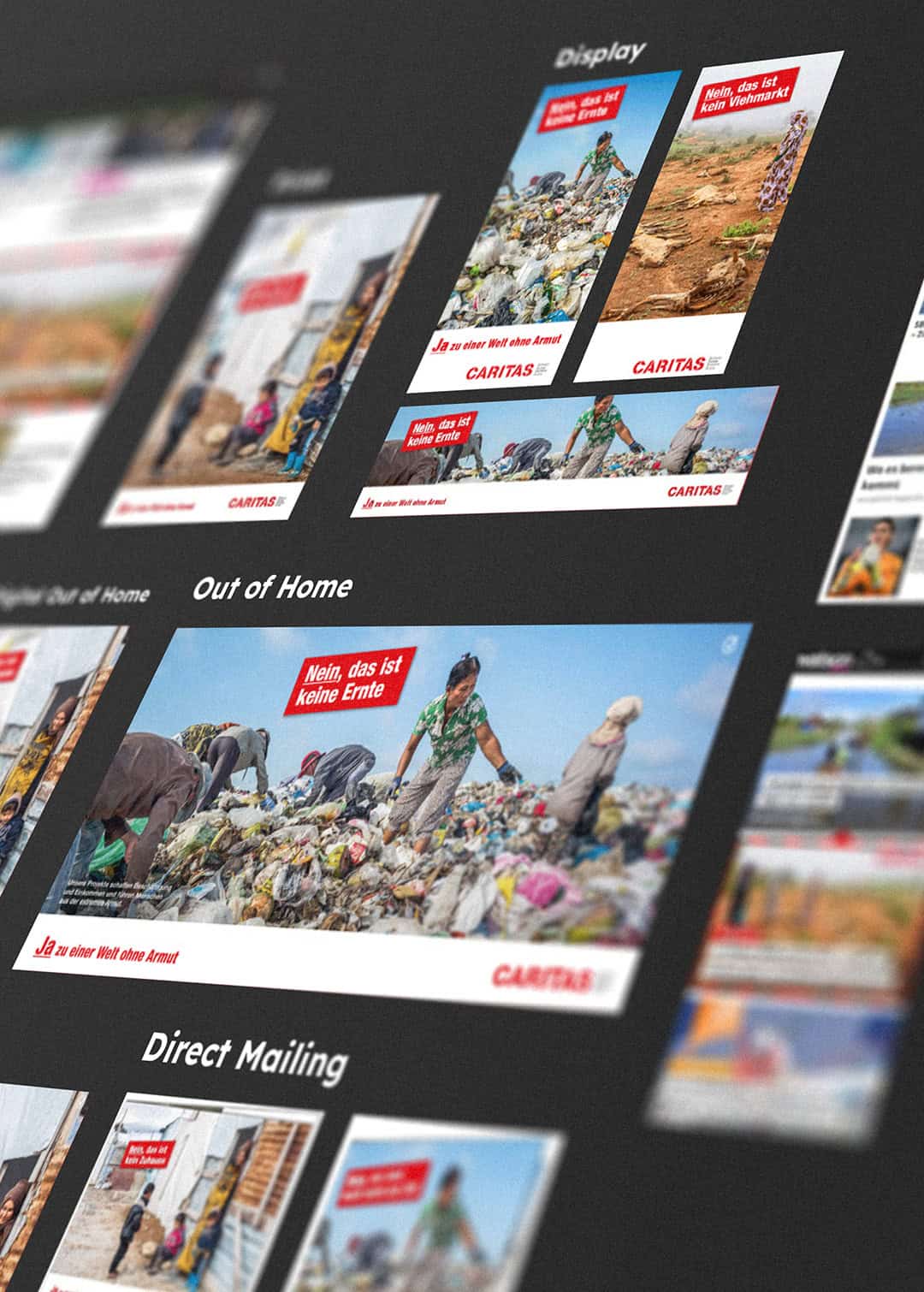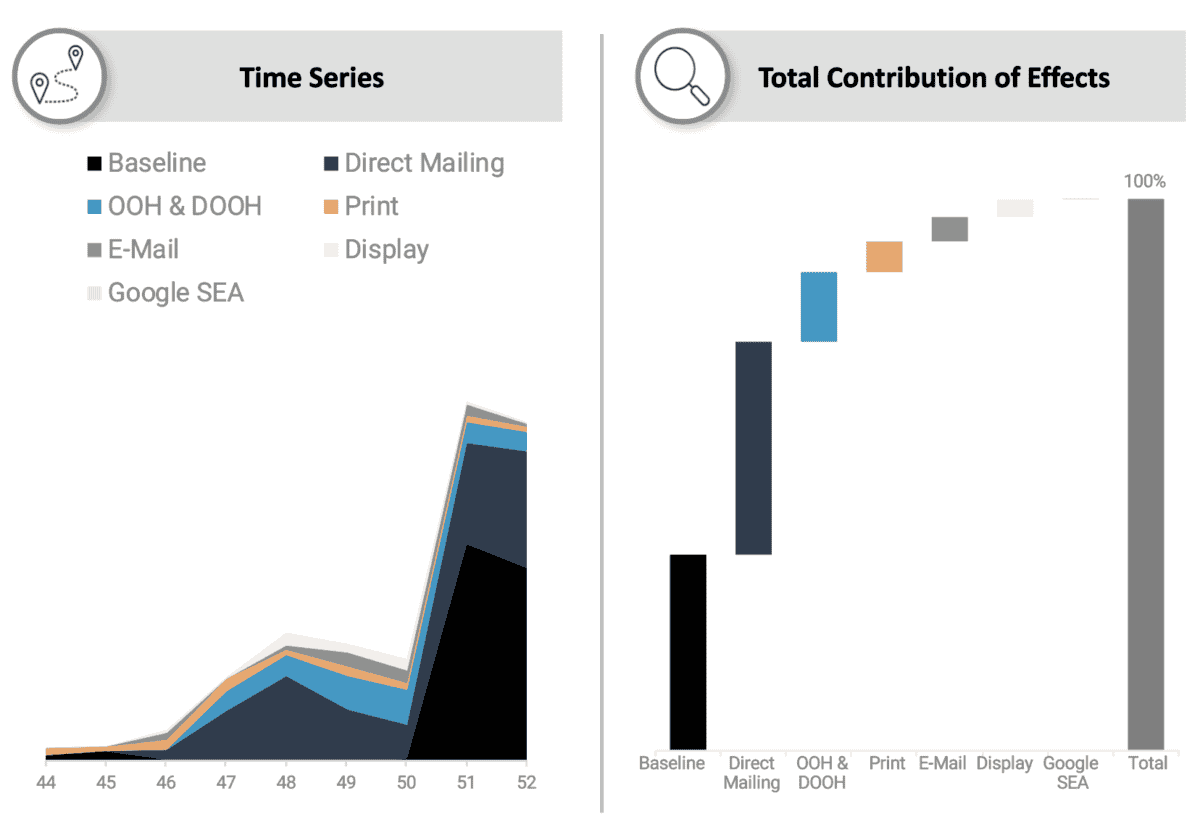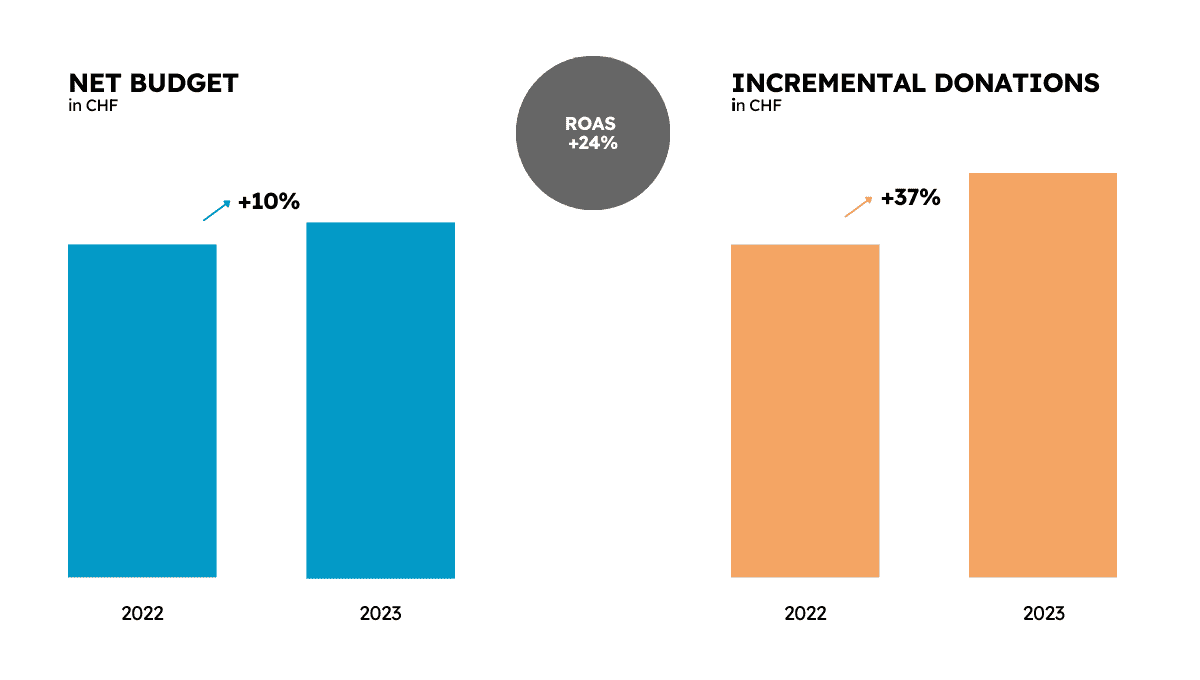Beyond Guesswork: Measuring Fundraising Impact with MMM
Discover which channels drive the most donations - and how cross-media expansion boosts fundraising impact.

The challenge
Preventing, combating, and alleviating poverty – this has been the mission of Caritas Switzerland for nearly 125 years. The cross-media Christmas campaign “A world without poverty” in 2023 aimed to generate donations for this cause and increase awareness of the non-profit organization’s (NPO) international work.
For any advertising company, understanding and optimizing the impact of advertising investments on business outcomes is essential. For NPOs like Caritas Switzerland, this is even more crucial, as their budgets are limited, and the responsible management of donation funds is a top priority. This raises an important question: Which channels in a cross-media fundraising campaign contribute most effectively to generating donations? And what is the effect of expanding the media mix cross-medially?
To provide a neutral assessment, Exactag conducted on behalf of Post Advertising a comprehensive study on the effectiveness, efficiency, and cross-media effects of various channels used in Caritas Switzerland’s Christmas campaign, “A world without poverty.”
Campaign framework & key parameters
Campaign Objective:
Branding and Fundraising- Examined Channels:
Direct Mailing
OoH & DooH
Print
Email
Display
Social Media Ads & Google SEA
Conversion Metric:
Donation volume in CHFAllocated Budget:
Actual net costs based on standard booking conditions for Zewo-certified organizations
Analysis Period:
January 1, 2022 – December 31, 2023Examination Period:
January 1, 2023 – December 31, 2023
(including pre-campaign period)Campaign Period:
November 1, 2023 – December 31, 2023
Study design
The goal of the study was to analyze the effectiveness of cross-media strategies and to better understand both the complexity and potential of such approaches. The two main questions were:
- How well does the cross-media media mix work, and which channels are most effective in triggering donations during the campaign?
- Can better results be achieved by focusing regionally and increasing advertising pressure in the Bern region?
To answer these questions, Exactag conducted a Marketing Mix Modeling study. This complex methodology combines three analyses:
Long-term analysis:
The analysis identifies natural transaction patterns over time, taking into account factors such as seasonality and external influences. Time series and regression models are used to establish a solid foundation for campaign evaluation.
Campaign Analysis
Advertising activities are examined in detail, with a breakdown by campaign and channel. The models incorporate insights from previous analyses and industry benchmarks to determine the specific impact of each campaign and channel over time.
Intra-Channel Analysis
The distribution of conversions within each channel is analyzed, identifying different subcategories through correlation analysis. To ensure accuracy, each subcategory is examined separately, maintaining clarity in the modeling process.
The analysis period covered two years, 2022 and 2023. The data analyzed came from various sources and was anonymized. Using statistical methods and machine learning techniques, patterns in the data were identified, revealing correlations between advertising spend and donation revenue that allowed for targeted optimizations.
Since physical mailings have always been particularly effective in fundraising, Caritas Switzerland chose both addressed and unaddressed mailings as the backbone of the Christmas campaign. To leverage the synergies of a cross-media strategy, the NPO also employed the following online and offline channels: Physical Posters (Out of Home), Digital Outdoor Advertising (Digital out of Home, DOOH), Print Advertisements, Display Ads, and Email Marketing.
In the Bern region, Caritas Switzerland significantly increased advertising pressure for Out of Home and DOOH compared to other regions to assess whether higher advertising intensity in this area leads to better results.
Learnings and results
The study identifies the impact contributions of individual channels within the cross-media campaign. Such results are rarely published by advertising companies. Therefore, the following graphic provides a particularly valuable insight – not just for NPOs, but for all industries.
The baseline includes donations that Caritas Switzerland would have generated during the campaign period even without advertising measures, as many individuals and companies traditionally donate during the Christmas season.
The graphic shows that well over 50% of donation volume can be attributed to the cross-media campaign. These additional donations, known as incremental donations, represent the net increase in donations that would not have been expected without the advertising measures.

For the 2023 Christmas campaign, Caritas Switzerland increased net campaign costs by 10%, leading to a 37% rise in incremental donations – a 24% increase in ROAS. This improved efficiency was driven by an optimized media mix, reinforcing the effectiveness of Caritas Switzerland’s multi-channel strategy.

In this case study, Return on Ad Spend (ROAS) was the key metric used to evaluate campaign efficiency. ROAS measures the ratio of generated donations to advertising spend. A high ROAS in a fundraising campaign indicates the NPO effectively invested its budget to maximize incremental donations.
"The insights from Marketing Mix Modeling help us allocate the media budget more precisely for the next campaign and target relevant audiences more effectively. The strong impact of direct mailings was confirmed and came as no surprise. However, we previously underestimated the impact of DOOH and display advertising on donation results, viewing them merely as awareness channels in our marketing mix. We will integrate, review, and validate these findings in our future campaigns."
A deeper look at the individual channels highlights key drivers of success:
- Three Top Performers: Direct Mailings, DOOH, and Display Advertising delivered the highest ROAS, working synergistically.
- Unaddressed Mailings had a lower ROAS but played a key role in acquiring new donors, ensuring long-term value.
- DOOH spending in Bern more than doubled the ROAS compared to other regions.
- Print achieved a high ROAS, but results should be viewed with caution as they include a large share of free filler ads provided to the NPO.
- Addressed Mailings to existing donors were the most effective fundraising measure.
- Optimized addressed Mailings to external addresses, enhanced by Post Advertising’s data analytics, significantly outperformed non-optimized versions.
Future implications
Recommendation 1: Utilize Channel Synergies A targeted realignment of the media mix towards the three top-performing channels—Direct Mailings, DOOH, and Display Advertising—enhances the overall effectiveness of fundraising campaigns.
Recommendation 2: Optimize Regionally Using data and analytics, high-potential regions for donation generation can be identified and marketing activities strengthened accordingly. It is essential to ensure that advertising pressure within these areas reaches an efficient level to maximize donations.
Recommendation 3: Adjust in Small Steps NPOs should make optimizations to campaign settings and the media mix incrementally, allowing for continuous monitoring and validation of expected effects.
This study provides NPOs with a strong argument against the frequently heard criticism that their money would be better spent directly on aid projects rather than on advertising. This study disproves that misconception by demonstrating that when NPOs strategically invest more in the most effective channels, their donation volume increases disproportionately. In the end, they have more funds available for their vital work.
These findings are compelling – but it’s important to remember that every case is unique. The insights gained from this study cannot simply be applied one-to-one. It provides the benchmark of how each media performs on average. A tailored Marketing Mix Modeling analysis is essential to uncover the specific dynamics of your own campaigns and unlock their full potential.
Schedule a free online Discovery Call with our experts. Get to know our solution and understand how you can benefit from our features.
About Caritas Switzerland

Caritas Switzerland prevents, alleviates and fights against poverty in Switzerland and worldwide in around 20 countries. Caritas Switzerland is an independent association with its Head Office in Lucerne and a member of the international Caritas network, which comprises 160 organisations throughout the world.
Together with the regional Caritas organisations, Caritas works to support people who are affected by poverty in Switzerland: families, single parents, the unemployed, the working poor. Caritas Switzerland has a range of offers in the areas of fighting poverty, asylum and integration.
Globally, Caritas Switzerland provides emergency relief in disasters and helps with reconstruction. With its projects in development cooperation, Caritas is active in the fields of income, climate and migration for children and adults.
Caritas advocates a society based on solidarity and a policy that takes socially disadvantaged people in Switzerland and abroad into account. Caritas is involved with analyses and statements on climate, social, migration and development policy.